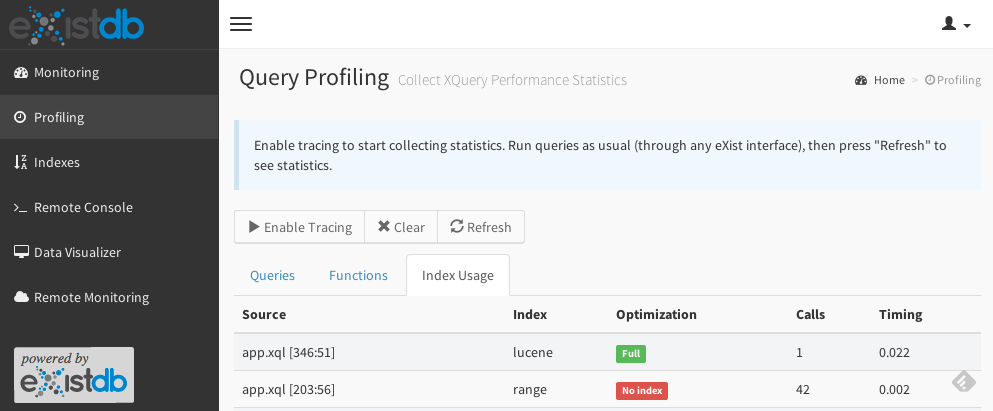Configuring Database Indexes
Overview
In this section, we discuss the types of database indexes used by eXist-db, as well as how they are created, configured and maintained. It assumes readers have a basic understanding of XML and XQuery.
Database indexes are used extensively by eXist-db to facilitate efficient querying of the database. This is accomplished both by system-generated and user-configured database indexes. The current (2.2) version of eXist-db by default includes the following types of indexes:
Properly configured indexes have a huge impact on database performance! Some expressions might run a hundred times faster with an index. This is particular applies to the range index: without a range index, eXist has to do a full scan over the context nodes to look up an element value, which severly limits performance and scalability.
-
New Range Indexes: A rewritten range index which provides superior performance on large data sets.
-
Full Text Indexes: This full text indexing module features faster and customizable full text indexing by transparently integrating Lucene into the XQuery engine. Prefer this index over the Legacy Full Text Index.
-
Legacy Range Indexes: These map specific text nodes and attributes of the documents in a collection to typed values.
-
Legacy Full Text Indexes: These map specific text nodes and attributes of the documents in a collection to text tokens.
-
NGram Indexes: These map specific text nodes and attributes of the documents in a collection to splitted tokens of n-characters (where n = 3 by default). This is very efficient for exact substring searches and for queries on scripts (mostly non-European ones) which can not be easily split into whitespace separated tokens and are thus a bad match for the Lucene full text index.
-
Spatial Indexes (Experimental): A working proof-of-concept index, which listens for spatial geometries described through the Geography Markup Language (GML). A detailed description of the implementation can be found in the Developer's Guide to Modularized Indexes.
-
xml:id Index : An index of all xml:id attribute values is automatically created. These values can be queried by fn:id().
-
Structural Indexes: This index keeps track of the elements, attributes, and the nodal structure of all XML documents in a collection. It is created and maintained automatically. No configuration required.
eXist-db features a modularized indexing architecture. Most types of indexes have been moved out of the database core and are now maintained as pluggable extensions. The full text, the ngram, the spatial and the new range indexes fall under this category.
Configuring Indexes
eXist-db has no "create index" command. Instead, indexes are configured in
collection-specific configuration files. These files are stored as standard XML
documents in the system collection: /db/system/config, which
can be accessed like any other document (e.g. using the Admin interface or Java
Client). In addition to defining settings for indexing collections, the
configuration document specifies collection-specific other settings such as triggers
or default permissions.
The contents of the system collection (/db/system/config)
should mirror the hierarchical structure of the main collection. Configurations are shared
by descendants in the hierarchy unless they have their own configuration (i.e. the
configuration settings for the child collection override those set for the parent).
If no collection-specific configuration file is created for any document, the global
settings in the main configuration file, conf.xml, will apply
by default. That being said, the conf.xml file should only
define the default global index creation policy.
To configure a given collection - e.g. /db/foo - create a
file collection.xconf and store it as /db/system/config/db/foo/collection.xconf. Note the replication of
the /db/foo hierarchy inside /db/system/config/. Subcollections which do not have a collection.xconf file of their own will be governed by the
configuration policy specified for the closest ancestor collection which does have
such a file, so you are not required to specify a configuration for every
collection. Note, however, that configuration settings do not cascade. If you choose
to deploy a collection.xconf file in a subcollection, you must
specify in that file all the configuration options you wish to
have applied to that subcollection (and any lower-level subcollections without
collection.xconf files of their own).
Due to backward compatibility concerns, the file does not have to be called
collection.xconf, which is now the preferred file name,
but it must have the .xconf
extension.
You can only have one.xconf file at each level.
Maintaining Indexes and Re-indexing
|
The eXist-db index system automatically maintains and updates indexes defined by the user. You therefore do not need to update an index when you update a database document or collection. eXist-db will even update indexes following partial document updates via XUpdate or XQuery Update expressions. The only exception to eXist-db's automatic update occurs when you add a new index definition to an existing database collection. In this case, the new index settings will only apply to new data added to this collection, or any of its sub-collections, and not to previously existing data. To apply the new settings to the entire collection, you need to trigger a "manual reindex" of the collection being updated. You can re-index collections using the Java Admin Client (shown on the right). From the Admin menu, select File»Reindex Collection. You can also index by passing an XQuery to eXist-db: xmldb:reindex('/db/foo')
|

|
General Configuration Structure and Syntax
Index configuration files are standard XML documents that have their elements and attributes defined by the eXist-db namespace:
http://exist-db.org/collection-config/1.0
The following example shows a configuration example:
All configuration documents documents have an <index> element directly below the root element, which encloses the index configuration. Only one<index> element is permitted in a document. Apart from the index configuration, the document may also contain settings not related to indexing, e.g. for triggers; these will not be covered here.
In the <index> element are elements that define the various index types. Each index type can add its own configuration elements, which are directly forwarded to the corresponding index implementation. The example above configures three different types of indexes: full text, range and ngram.
Namespaces
If the document to be indexed uses namespaces, you should add a xmlns declaration for each of the required namespaces to the <index> element:
The example configuration above creates two indexes on a collection of
atom documents. The two elements which should be indexed are both in the
Check Index Usage
The quickest way to see if an index was used or not is to go to the menu item in the Monex Monitoring and Profiling application.
-
Click on to enable usage statistics.
-
Run the query you would like to profile. The profiler will collect statistics about any query running on the database instance, no matter how the query is called.
-
Click and switch to the tab.

The table provides the following information:
- Source
-
The query containing the expression. The line/column of the expression is given in brackets. For queries stored in the database, the file name will be shown. Dynamically executed queries are displayed with the name "String".
- Index
-
Type of the index used: "range" for the old range index, "new-range" for the new range index, "lucene" for the full text index.
- Optimization
-
Either "Full", "Basic", or "No index". The meaning of those labels is as follows:
-
"Full": the expression was rewritten by the optimizer to make full use of the index. This is the best you can achieve.
-
"Basic": the index was used, but the expression was not rewritten by the optimizer. This is better than "No index" but still several times slower than "Full". Most probably the context of the expression was too complex to rewrite it.
-
"No index": no index defined. Expression is evaluated in "brute force" mode.
-
- Calls
-
The number of calls to the expression.
- Elapsed time
-
The time elapsed for all calls together. The time is measured for the index lookup only. The absolute numbers are not reliable (due to measurement errors), but they show a tendency: if a lookup takes relatively longer than other expressions, it might be worth to optimize it with an index.
Enabling Index Modules
While some indexes (n-gram, full text) are already pre-build in the standard eXist-db distribution, other modules may need to be enabled first. For example, the spatial index depends on a bunch of external libraries, which do not ship with eXist-db. However, enabling the spatial index is a simple process:
-
Copy the properties file
extensions/indexes/build.propertiesand store it aslocal.build.propertiesin the same directory if it does not already exist. -
Edit
extensions/indexes/local.build.properties:# N-gram module include.index.ngram = true # Spatial module include.index.spatial = falselocal.build.properties To include an index, change the corresponding property to "true".
-
Call the Ant build system once to regenerate the eXist-db libraries:
build.sh
or
build.bat
The build process should create a jar file for every index implementation in
directory lib/extensions. For example, the spatial index is
packaged into the jar exist-spatial-module.jar.
Once the index module has been built, it can be announced to eXist-db. To activate an
index plugin, it needs to be added to the <modules> section within
the global configuration file conf.xml:
Every <module> element needs at least an id and class attribute. The class attribute contains the name of the plugin class, which has to be an implementation of org.exist.indexing.Index.
All other attributes or nested configuration elements below the <module> element are specific to the implementation and will differ between indexes. They should be documented by the index implementor.
If an index implementation cannot be loaded from the specified class, the entry will simply be ignored. A warning will be written to the logs which should provide more information on the issue which caused the configuration to fail.
Automatic Indexes
Structural index
This index keeps track of the elements (tags), attributes, and nodal structure
for all XML documents in a collection. It is created and maintained
automatically in eXist-db, and can neither be reconfigured nor disabled by the
user. The structural index is required for nearly all XPath and XQuery
expressions in eXist-db (with the exception of wildcard-only expressions such as
"//*"). This index is stored in the database file
elements.dbx.
Technically, the structural index maps every element and attribute qname (or qualified name) in a document collection to a list of <documentId, nodeId> pairs. This mapping is used by the query engine to resolve queries for a given XPath expression.
For example, given the following query:
//book/section
eXist-db uses two index lookups: the first for the <book> node, and the second for the <section> node. It then computes the structural join between these node sets to determine which <section> elements are in fact children of <book> elements.